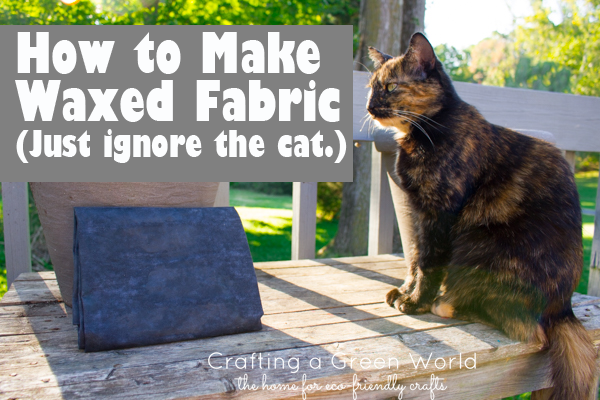
Fabrics like vinyl or laminated cotton are commonly used in sewing, whenever you’d like a tough, water-resistant fabric.
Reusable lunchbags. Snack bags. Tablet cases. Diaper bags.
Unfortunately, neither vinyl nor laminated cotton are great choices for the environment, so what do you do if you want to sew something that’s water-resistant, but you don’t want to use plastic?
You make your own waxed fabric!
The process is simple, the results are natural (although NOT vegan), and when you’re finished, you’ll have a sturdy, water-resistant fabric that you can sew into whatever you like.
You will need:
beeswax. Check out your farmer’s market for a local beekeeper.
fabric. My favorite thing about this method is that you can use any cotton fabric that you fancy. If you went shopping for waxed fabric, you’d have a very limited selection of colorways to choose, but when you make it yourself, you can choose whatever you’d like from your stash–just remember that the wax will darken your fabric a bit.
cardboard or newspaper. You’ll want enough to make a thick layer of padding for the fabric.
paintbrush. I can’t remember now what tutorial it was for, but I know that I’ve previously suggested that you keep a paintbrush just to use with your beeswax. Does anyone remember what I was teaching you to make when I told you that?
heat gun. I know you’re going to want to ask me if a blow dryer will work instead, and the answer is that I don’t know, because I don’t own one, although I don’t see why it wouldn’t. See if your blow dryer will melt a little chunk of beeswax and if it will, you should be good to go.
1. Cut your fabric to size, then iron and de-lint it. Trim your fabric down to a size that’s just a little larger than you need, then iron out the wrinkles. Get some masking tape and look over your fabric, picking up any cat hairs or stray pieces of lint–whatever is on the fabric when you wax it will STAY on that fabric for freaking ever.
2. Lay the fabric over the layer of cardboard or newspaper. You’d think that you’d want something non-porous, so that it doesn’t soak up any of the beeswax meant for the fabric, but you actually don’t want your fabric super-saturated, or it’ll be stiff and will crack when you fold it. Instead, make this layer of cardboard or newspaper thick enough to catch all of the excess beeswax, and then recycle it when you’re finished.
3. Melt your beeswax. You might have noticed by now that all of my beeswax tutorials call for a dedicated crock pot–it’s by far the best method for melting beeswax and keeping it melted while you work, and if you wipe it out when you’re done, you can use the crock pot for other crafts. I bought mine from Goodwill ages ago for the whopping price of $4.50–I think I’ve gotten my money’s worth!
4. Paint on a layer of beeswax. Dip your paintbrush into the melted beeswax, then begin to paint a thin layer of beeswax over the entire surface of the fabric. Don’t worry about making it even or about any puddles of excess beeswax–we’ll take care of those later.
5. Melt the beeswax into the fabric. Set the heat gun to its hottest setting, then hold it just a couple of inches above the surface of the fabric. Run the heat gun back and forth over the fabric, watching the beeswax magically melt into it.
6. Turn the fabric over and repeat. When you go to lift of the fabric, you’ll notice that you’ll have to pull it from the cardboard–excess beeswax will have made it sticky in spots, but we’re about to fix that. Flip the fabric over so it faces down, and again run the heat gun over it, but more quickly this time. You’ll be able to see any differences in shading that will tell you where the beeswax spread unevenly, so just heat those spots again, and the beeswax will distribute more evenly.
You can now fold and store your waxed fabric, and sew all kinds of great things with it. I’m going to make the tablet case from Present Perfect out of this particular piece of waxed fabric, so I’ll keep you posted with my results!



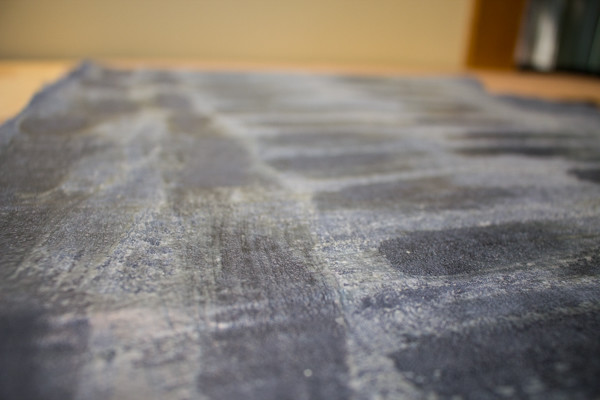
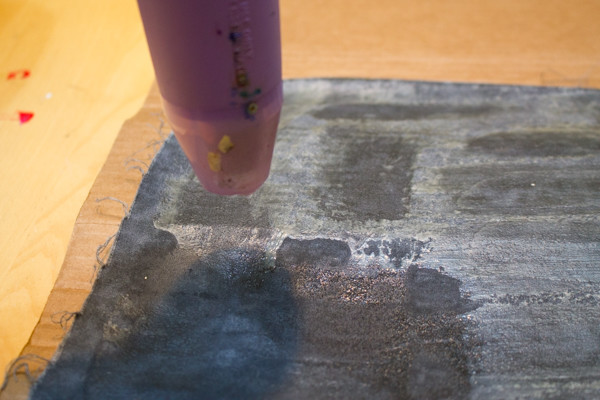
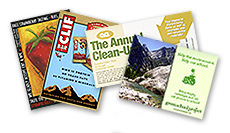

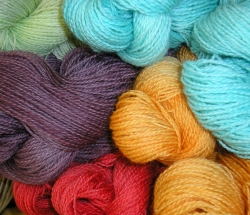

Doesnt the wax gum up your sewing machine? Wouldn’t it be better to do this to finished product?
Have you made a garment with this fabric? How does it wash, can you iron and is it ok to dry clean or tumble dry?
I haven’t made anything so big, although it would make a good waterproof hat or poncho. I like it as food packaging, lunch bags, and waterproof totes. I wipe it clean, although you could probably machine wash it on cold and delicate. Don’t tumble dry it and by no means iron it! You’ll melt all the wax off of the fabric and onto everything else if you do.
Hi Julie. Great post! Did you pre wash your fabric before waxing?
I do! I don’t know if it makes a difference or not, though. My general policy for fabric, unless it’s felt or wool, is to prewash it as soon as I bring it home. That way, unless the cat lays on it (which the cat often does…), the fabric is ready to go whenever I am!
Hi Julie. This looks super useful! I am looking to eliminate plastic wrap and plastic storage containers from my kitchen. Will this waxed cloth work to wrap fresh fruit, veggies and various leftover food? How many times typically can the cloth be reused? Once it is no longer effective, can the fabric be re-waxed? Cheers!
I think it works great with leftovers–don’t leave any gaps to the air, and the food will remain fairly well sealed. My waxed cloth generally only deteriorates when it’s been used in the refrigerator, and then only if someone tries to unfold it when it’s still cold and stiff so that the wax cracks. You can maybe rewax the fabric, but for some reason, that second time it’s a lot harder to keep little fuzzy bits and lint, etc., off of the fabric while it’s being waxed.
This is something I want to try to do as part of my eliminating plastic food wrapping.Would it work on a large piece of fabric-e.g. For a shower curtain?
Have our tried using waxed paper?
Use a glass container with a lid.
Hi, I’m also curious whether you could sew with a sewing machine, without it gumming your machine. I know for fact that wraps with resin do gum up but maybe not with pure wax?
How easy is this to do on a canvas bag?
Would direct sunlight on a hot day melt the wax??
How necessary is the heat gun??